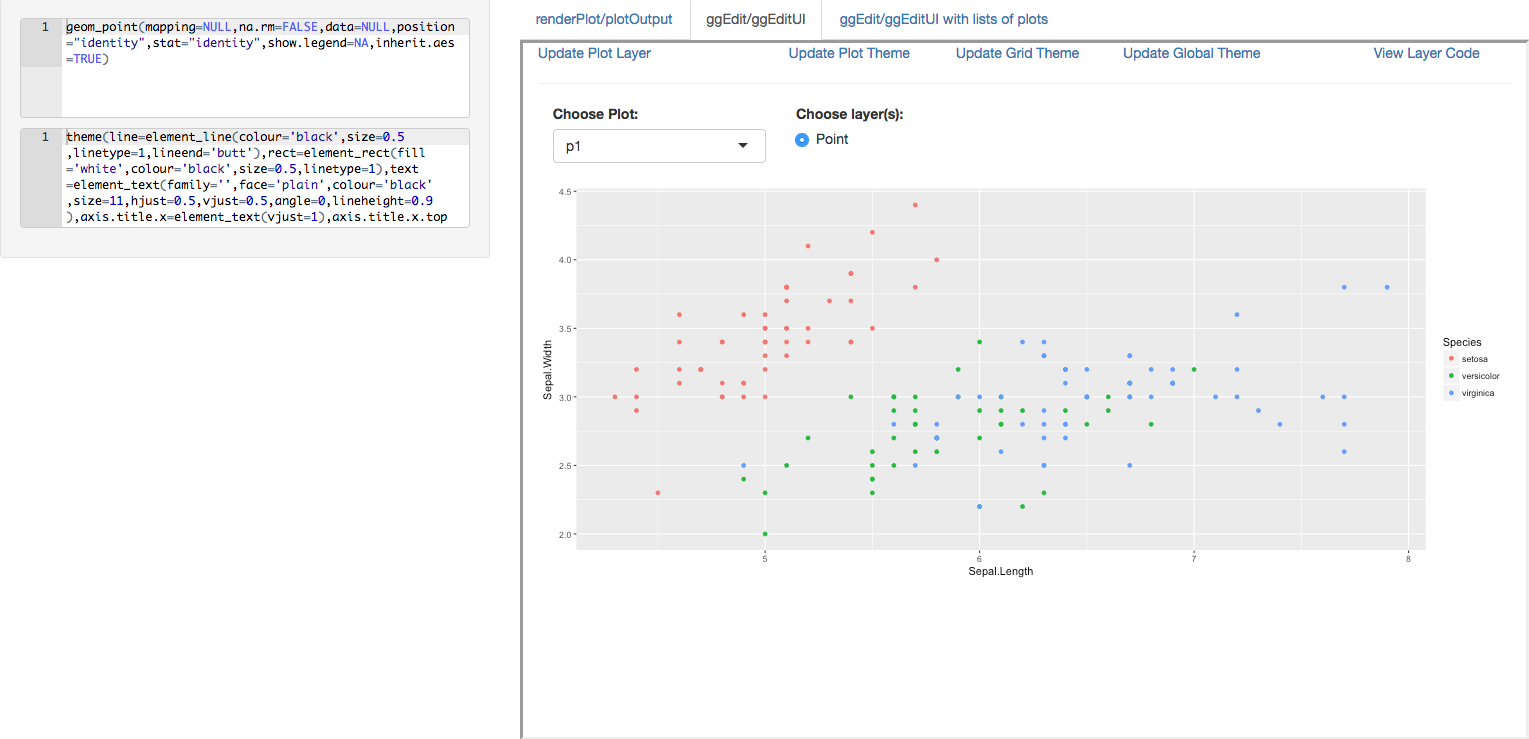We are happy to bring the
slick JavaScript library to R. It is self-described as “the last carousel you’ll ever need”. This carousel is based on putting the elements of the carousel in a
div HTML tag. This makes the carousel very versatile in what can be placed inside. Regular objects that are placed in a carousel can be for example: images, plots, tables, gifs, videos, iframes and even htmlwidgets.
This tool helps review multiple outputs in an efficient manner and saves much needed space in documents and Shiny applications, while creating a user friendly experience.
These carousels can be used directly from the R console, from RStudio, in Shiny apps and R Markdown documents.
Installation
CRAN
install.packages('slickR')
Github (dev)
devtools::install_github('metrumresearchgroup/slickR')
Examples
There are many options within the slick carousel, to get started with the basics we will show a few examples in the rest of the post. If you want to try out any of the examples you can go to this
site where they are rendered and can be tested out.
library(svglite)
library(lattice)
library(ggplot2)
library(rvest)
library(reshape2)
library(dplyr)
library(htmlwidgets)
library(slickR)
Images
Some web scraping for the images example….
#NBA Team Logos
nbaTeams=c("ATL","BOS","BKN","CHA","CHI","CLE","DAL","DEN","DET","GSW",
"HOU","IND","LAC","LAL","MEM","MIA","MIL","MIN","NOP","NYK",
"OKC","ORL","PHI","PHX","POR","SAC","SAS","TOR","UTA","WAS")
teamImg=sprintf("https://i.cdn.turner.com/nba/nba/.element/img/4.0/global/logos/512x512/bg.white/svg/%s.svg",nbaTeams)
#Player Images
a1=read_html('http://www.espn.com/nba/depth')%>%html_nodes(css = '#my-teams-table a')
a2=a1%>%html_attr('href')
a3=a1%>%html_text()
team_table=read_html('http://www.espn.com/nba/depth')%>%html_table()
team_table=team_table[[1]][-c(1,2),]
playerTable=team_table%>%melt(,id='X1')%>%arrange(X1,variable)
playerName=a2[grepl('[0-9]',a2)]
playerId=do.call('rbind',lapply(strsplit(playerName,'[/]'),function(x) x[c(8,9)]))
playerId=playerId[playerId[,1]!='phi',]
playerTable$img=sprintf('http://a.espncdn.com/combiner/i?img=/i/headshots/nba/players/full/%s.png&w=350&h=254',playerId[,1])
Simple carousel
Let’s start easy: show the team logos one at a time with dots underneath
slickR(obj = teamImg,slideId = 'ex1',height = 100,width='100%')
Grouped Images
There are players on each team, so lets group the starting five together and have each dot correspond with a team:
slickR(
obj = playerTable$img,
slideId = c('ex2'),
slickOpts = list(
initialSlide = 0,
slidesToShow = 5,
slidesToScroll = 5,
focusOnSelect = T,
dots = T
),
height = 100,width='100%'
)
Replacing the dots
Sometimes the dots won’t be informative enough so we can switch them with an HTML object, such as text or other images.
We can pass to the customPaging argument javascript code using the
htmlwidgets::JS function.
Replace dots with text
cP1=JS("function(slick,index) {return '<a>'+(index+1)+'</a>';}")
slickR(
obj = playerTable$img,
slideId = 'ex3',
dotObj = teamImg,
slickOpts = list(
initialSlide = 0,
slidesToShow = 5,
slidesToScroll = 5,
focusOnSelect = T,
dots = T,
customPaging = cP1
),
height=100,width='100%'
)
Replace dots with Images
cP2=JS("function(slick,index) {return '<a><img src= ' + dotObj[index] + ' width=100% height=100%></a>';}")
#Replace dots with Images
s1 <- slickR(
obj = playerTable$img,
dotObj = teamImg,
slickOpts = list(
initialSlide = 0,
slidesToShow = 5,
slidesToScroll = 5,
focusOnSelect = T,
dots = T,
customPaging = cP2
),height = 100,width='100%'
)
#Putting it all together in one slickR call
s2 <- htmltools::tags$script(
sprintf("var dotObj = %s",
jsonlite::toJSON(teamImg))
)
htmltools::browsable(htmltools::tagList(s2, s1))
Plots
To place plots directly into slickR we use svglite to convert a plot into svg code using xmlSVG and then convert it into a character object
plotsToSVG=list(
#Standard Plot
xmlSVG({plot(1:10)},standalone=TRUE),
#lattice xyplot
xmlSVG({print(xyplot(x~x,data.frame(x=1:10),type="l"))},standalone=TRUE),
#ggplot
xmlSVG({show(ggplot(iris,aes(x=Sepal.Length,y=Sepal.Width,colour=Species))+
geom_point())},standalone=TRUE),
#lattice dotplot
xmlSVG({print(dotplot(variety ~ yield | site , data = barley, groups = year,
key = simpleKey(levels(barley$year), space = "right"),
xlab = "Barley Yield (bushels/acre) ",
aspect=0.5, layout = c(1,6), ylab=NULL))
},standalone=TRUE)
)
#make the plot self contained SVG to pass into slickR
s.in=sapply(plotsToSVG,function(sv){paste0("data:image/svg+xml;utf8,",as.character(sv))})
slickR(s.in,slideId = 'ex4',slickOpts = list(dots=T), height = 200,width = '100%')
Synching Carousels
There are instances when you have many outputs at once and do not want to go through all, so you can combine two carousels one for viewing and one for searching.
slickR(rep(s.in,each=5),slideId = c('ex5up','ex5down'),
slideIdx = list(1:20,1:20),
synchSlides = c('ex5up','ex5down'),
slideType = rep('img',4),
slickOpts = list(list(slidesToShow=1,slidesToScroll=1),
list(dots=F,slidesToScroll=1,slidesToShow=5,
centerMode=T,focusOnSelect=T)
),
height=100,width = '100%'
)
Iframes
Since the carousel can accept any html element we can place iframes in the carousel.
There are times when you may want to put in different DOMs rather than an image in slick. Using slideType you can specify which DOM is used in the slides.
For example let’s put the help Rd files from ggplot2 into a slider using the helper function getHelp. (Dont forget to open the output to a browser to view the iframe contents).
geom_filenames=ls("package:ggplot2",pattern = '^geom')
slickR(unlist(lapply(geom_filenames,getHelp,pkg = 'ggplot2')),slideId = 'ex6',slideType = 'iframe',height = '400px',width='100%',slickOpts = list(dots=T,slidesToShow=2,slidesToScroll=2))
Jonathan Sidi joined Metrum Research Group in 2016 after working for several years on problems in applied statistics, financial stress testing and economic forecasting in both industrial and academic settings. To learn more about additional open-source software packages developed by Metrum Research Group please visit the Metrum website. Contact: For questions and comments, feel free to email me at: [email protected] or open an issue for bug fixes or enhancements at github. 







 We are pleased to announce the release of the ggedit package on
We are pleased to announce the release of the ggedit package on 